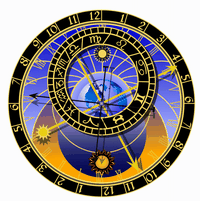Have you ever wondered why people are the way they are?
How we can all look at the same image, yet still have widely differing perspectives. Why we choose certain hobbies. What attracts us to one another? The answers could well be in the constellations above our heads, as we enter the world.
In modern times horoscopes have become main stream entertainment. Foretelling of love, wealth and warnings of the difficulties we face ahead; but these are only scratching at the surface of what is a much deeper process of Astrology. Astrology is a process that can help us attain a greater understanding of our selves and the people we share our planet with.
The birth-chart, also referred to as a horoscope, is a diagram drawn for a particular date, time and place, showing precise positions of the sun, moon and planets all relating to the birth of an individual. We can break this diagram down into four key components: Zodiac signs, Planets, Houses and the relationship between them, known as Aspects. Together, these elements can be used to interpret the personality and nature of the individual in question, and could even estimate a successful career path they could pursue.
Zodiac Signs
A circle is drawn through the sky that includes the path of the sun, the moon and the planets, as they appear to move around the Earth. This is known as the Zodiac circle; from there the circle is split into twelve equal thirty degree sections: Capricorn, Aquarius, Pisces, Aries, Taurus, Gemini, Cancer, Leo, Virgo, Libra, Scorpio and Sagittarius. A particular constellation lies behind each of the twelve sections and some constellations are much larger than others but have been reduced to twelve equal sizes to help the interpretation of the birth-chart.
There are general assumptions made about individuals born under the Zodiac Signs. Gemini are flirtatious for instance or a Libra is ‘charming’. While this may be true in some cases, the Zodiac Sign on its own is not a true reflection of the possibilities of Astrology, and is only the beginning in mapping a person’s birth-chart.
Planets
While modern technology has allowed us to push through into the boundaries of space exploration marring some of the ‘magical’ wonder of the planets that occupy our sky, Astrology explains the affects that planets can have on our birth-chart and the associated traits that can then impact on our personalities.
Mars has been a planet portrayed as the one fruitful planet that housed life in our solar system, in many science fiction films and literature throughout the years but in Astrology the red planet is associated with violence and warfare, no doubt due to the striking reddish color of its surface. It is also said to represent the masculinity in the personality of both sexes and is related to aggression and heat.
Venus is associated with purity and love in personal relationships. It can positively encourage gentleness or friendship, while it can also make the individual careless or indecisive.
Planets, along with Zodiac signs, go some way to indicating the personality traits, hobbies and successful career paths of an individual, but are in need of a third component to complete a full birth-chart.
Houses
A birth-chart not only uses the twelve Zodiac Signs but also, uses twelve sections know as houses. Houses govern a different aspect of the life of the owner of the horoscope. Planets placed within them or related to them, have something to say about a specific area of the character of a person.
The first house begins at the horizon line and the rest follow anti-clockwise, varying in size depending on the type of house system used. There are many different types of house systems but one of the earliest and still very common today is The Equal House system. The big advantage of using this type of house system is it can be drawn from anywhere in the world, while others can be restricted to certain regions.
The first house of Aries and Mars is considered the most important and has been called the house of fulfillment as it describes the personality, attitude, temperament, health and wellbeing of the owner of the birth-chart.
Aspects
The last tool of the birth-chart is the relationship between all the other elements known as Aspects. They are the specific angles made by planets to each other and are important in interpretation. To be ‘in aspect’ Planets need to be at specific angular distance from each other within the horoscope.
When two planets occupy the same point in a chart, this is called Conjunction and is the most powerful of Aspects. Conjunction can have either a negative or positive impact to other influences in the birth-chart.
Pulling all the components of a birth-chart together, we can look at what it says at the time of our birth, to allow us to see what affects could be present and what standing they might bear on our characters. We might just find that the answer to who we are was already written in the stars.
If you enjoyed this article, check out History Of Western Astrology


